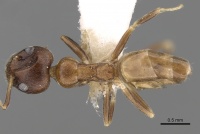Axinidris tridens
| Axinidris tridens | |
|---|---|

| |
| Scientific classification | |
| Kingdom: | Animalia |
| Phylum: | Arthropoda |
| Class: | Insecta |
| Order: | Hymenoptera |
| Family: | Formicidae |
| Subfamily: | Dolichoderinae |
| Genus: | Axinidris |
| Species: | A. tridens |
| Binomial name | |
| Axinidris tridens (Arnold, 1946) | |
A. tridens has been collected foraging on a partially decayed tree in a primary forest.
Identification
Snelling (2007) - Antennal scape shaft, pronotum and gastral terga without erect hairs; pronotum densely pubescent; medial carina acute in profile.
Keys including this Species
Distribution
Distribution based on Regional Taxon Lists
Afrotropical Region: Malawi (type locality), South Africa.
Distribution based on AntMaps
Distribution based on AntWeb specimens
Check data from AntWeb
Countries Occupied
| Number of countries occupied by this species based on AntWiki Regional Taxon Lists. In general, fewer countries occupied indicates a narrower range, while more countries indicates a more widespread species. |

|
Estimated Abundance
| Relative abundance based on number of AntMaps records per species (this species within the purple bar). Fewer records (to the left) indicates a less abundant/encountered species while more records (to the right) indicates more abundant/encountered species. |

|
Biology
Species of Axinidris appear to nest exclusively within hollow plant stems, both living and dead, and in rotten wood. They are found in forested areas throughout the Afrotropical region, but are most abundant and diverse in the moist equatorial forests. Workers are primarily arboreal foragers, but may occasionally forage in ground litter.
Castes
Known only from the worker caste.
Nomenclature
The following information is derived from Barry Bolton's Online Catalogue of the Ants of the World.
- tridens. Engramma tridens Arnold, 1946: 58, figs. 10, 10a (q.) MALAWI.
- Type-material: lectotype worker (by designation of Shattuck, 1991: 119), 2 paralectotype workers.
- Type-locality: lectotype Malawi (“Nyasaland”): Mlanje (= Mulanje), 1944 (G. Arnold); paralectotypes with same data.
- Type-depository: SAMC.
- Combination in Axinidris: Shattuck, 1991: 119; Bolton, 2007a: 120.
- Status as species: Shattuck, 1991: 119 (redescription); Shattuck, 1994: 10; Bolton, 1995b: 77; Snelling, R.R. 2007: 572.
- Distribution: Malawi, South Africa.
Unless otherwise noted the text for the remainder of this section is reported from the publication that includes the original description.
Description
Worker
Shattuck (1991) - (n=2). OOD 0.33, EL 0.20-0.25, HL 0.86-0.95, EW 0.13-0.16, HW 0.81-0.88, CNW 0.06-0.Q7, CND 0.05, SL 0.72-0.82, AL 1.07, PpW 0.31-0.34, SW 0.23-0.26, CI 0.93-0.94, CNI 0.64-0.95, REL 0.24-0.28, ScI 0.88-0.93, SpI 1.67-1.73. Propodeal spines reduced to angles; medial propodeal carina present, tooth-like dorsally.
Head colliculate to imbricate, dorsal surface superimposed with fine scabriculous sculpturing; area near the mandibular insertion with a narrow area ofstrigulate sculpturing. Erect hairs limited to one pair medial and posterior of the compound eyes and one pair near the anterior clypeal margin. Erect and suberect hairs absent from antennal scapes. Anterior and lateral areas of pronotum smooth and lacking erect hairs, postero-dorsal regions colliculate to imbricate. Extreme anterior margin of mesonotum smooth, remainder of mesonotum and entire propodeum scabriculous. Anterior edge of propodeal spiracles even with propodeum, posterior edge depressed relative to the anterior surface of propodeum and thus directing the spiracular opening posteriorly. Medial propodeal carina weak, tooth-like dorsally, and located on the declivitous face only. Propodeal spines reduced to angles and with the area between them flat. Erect hairs absent from gastric tergites. Body colour reddish yellow with the head and legs slightly darker (tarsi pale yellow); mandibles yellow. Discussion. Atridens can be distinguished from other species by the tooth-like configuration of the medial propodeal carina.
Type Material
Shattuck (1991) - Three syntype workers from MALAWI: Mlanje (= Mulanje) (South African Museum) [examined]. The upper right specimen (the only individual possessing a head) is here designated as LECTOTYPE.
References
- Arnold, G. 1946. New species of African Hymenoptera. No. 6. Occas. Pap. Natl. Mus. South. Rhod. 2: 49-97 (page 58, fig. 10 queen described)
- Shattuck, S. O. 1991. Revision of the dolichoderine ant genus Axinidris (Hymenoptera: Formicidae). Syst. Entomol. 16: 105-120. (page 119, combination in Axinidris)
- Snelling, R. R. 2007. A review of the arboreal Afrotropical ant genus Axinidris. Pages 551-579 in Snelling, R. R., B. L. Fisher and P. S. Ward. Advances in ant systematics (Hymenoptera: Formicidae): Homage to E.O. Wilson - 50 years of contributions. Memoirs of the American Entomological Institute, 80.
References based on Global Ant Biodiversity Informatics
- Arnold G. 1946. New species of African Hymenoptera. No. 6. Occasional Papers of the National Museum of Southern Rhodesia. 2: 49-97.
- IZIKO South Africa Museum Collection
- Shattuck S. O. 1991. Revision of the dolichoderine ant genus Axinidris (Hymenoptera: Formicidae). Systematic Entomology 16: 105-120.
- Shattuck S. O. 1994. Taxonomic catalog of the ant subfamilies Aneuretinae and Dolichoderinae (Hymenoptera: Formicidae). University of California Publications in Entomology 112: i-xix, 1-241.
- Snelling, R. R. 2007. A review of the arboreal Afrotropical ant genus Axinidris, pp. 551-579. In Snelling, R. R., B. L. Fisher, and P. S. Ward (eds). Advances in ant systematics (Hymenoptera: Formicidae): homage to E. O. Wilson 50 years of contributions. Memoirs of the American Entomological Institute, 80.

